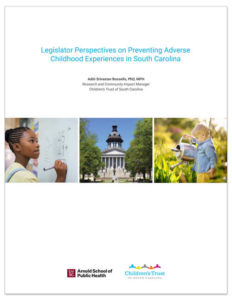Aditi Srivastav Bussells, Children’s Trust research and community impact manager, provides insight on a unique study conducted with state legislators in South Carolina on ways in which adverse childhood experiences (ACEs) can be prevented through public policy efforts. Her interviews with 24 lawmakers led to the publication of the booklet, “Legislator Perspectives on Preventing Adverse Childhood Experiences in South Carolina,” which details their outlooks on the promotion of child health and well-being. Bussells leads the S.C. ACE Initiative and KIDS COUNT South Carolina. She recently completed her Ph.D. as a Doris Duke Charitable Foundation Fellow at the University of South Carolina’s Arnold School of Public Health.
Why was it important to do this study?

This study, “Legislator Perspectives on Preventing Adverse Childhood Experiences in South Carolina (PDF),” is the result of the momentum being built around ACEs both nationally and statewide. People are beginning to recognize the importance of shifting our approach in public health from focusing on changing health behaviors to understanding why they occur in the first place. That’s the whole idea of, ‘What happened to you,’ instead of, ‘What’s wrong with you.’ There are several examples of successful state initiatives, including our own statewide ACE Initiative, that have been successful in increasing awareness and mobilizing community support around ACEs using existing research.
But in order to make long-term, meaningful change, we know that education and raising awareness aren’t enough. We need our systems and policies to change. And to change those systems and policies, we have to work with legislators. That’s where I saw an opportunity. There’s a lot of research on the health and social impact of ACEs, but much of it does not get translated into policy action. To do that, it is important to understand what legislators know and think about the issue that we are trying to address and prevent. Additionally, it’s important that the research to yield practical recommendations for child health, and this study was the perfect fit.
How does this study inform work around child well-being?
It provides important insight on what legislators know and don’t know about ACEs, and it also gives child health researchers and advocates key recommendations for what may be feasible for policy approaches to child well-being. You’ll notice as you read the report that while the topic of the study was ACEs, many of the discussions we get into are about helping kids succeed in general. I could see an advocacy organization, a coalition, or even a concerned citizen taking the results of this study to help inform their advocacy work around child well-being. A study like this has not been done before so it provides innovative and timely information on policy approaches to ACEs and child health and well-being.
Can you discuss what it was like to conduct this study?
Well, I should mention that this report highlights some of the many findings of the study, which also include interviews with child-serving professionals to develop feasible, evidence-based policy solutions for ACEs. Prior to conducting the study, I worked with the University of South Carolina’s Institutional Review Board to make sure that all of the proper protocols were in place to protect the confidentiality of the participants. Next, I developed and pretested a set of questions used to guide my interviews. After finalizing my interview guide based on input from other researchers and policy advocates in South Carolina, I developed a list of legislators based on their roles on key committees related to public health; the regions they served; and their race/ethnicity, gender, and political affiliation. It was important for me to hear the perspectives of legislators who had never heard of ACEs so this list included some who may not have worked on children’s issues. I reached out to the legislators through formal letters to their districts and their Columbia offices before following up in person. I think the follow-ups were key because they helped put a face to the name of the student who was requesting this information.
Twenty-four legislators agreed to be a part of the study, which is a strong sample size for a qualitative study. The interviews, on average, lasted 55 minutes. I was impressed by the time and effort the participants put into our interviews. All of them were excited to be able to provide their insight and were eager to see the results.
How did you narrow down all the interview data?
As I mentioned, this report is one piece of larger research looking at program and policy approaches to ACEs, which meant there were a lot of themes and recommendations that arose. I used a qualitative data program called Dedoose to help organize the data and used qualitative techniques to help map the interview excerpts into themes that emerged in the analysis process. I am very excited to share more of these themes in the form of research briefs.
What level of involvement did Children’s Trust have in the process?
Children’s Trust of South Carolina is unique in its ability to conduct research and evaluation in-house. With the help of our policy and programs teams, I was fortunate to be able to leverage the partnerships that Children’s Trust has with the community and with legislators to assist with the recruitment of participants and pretest my interview guide. Dr. Melissa Strompolis, the organization’s director of research and evaluation, was vital in helping to finalize the results of the study by reviewing the key themes that arose, and the communications team has been instrumental in dissemination of the research.
You mentioned that there are going to be peer-reviewed publications on this study. Why was it important for you to release a more informal report on the key legislator findings?
Dissemination is an important step of research. But for dissemination to be meaningful, you must convey research in a way that is relatable and digestible. Participants in this study mentioned that they value research, but long reports or peer-reviewed publications may not be as effective in conveying research findings compared to research briefs that provide important highlights. This report reflects my commitment to making research more accessible and reinforces the approach of Children’s Trust to research-informed prevention efforts.
If you would like to learn more about all of our child data, please visit our Resources webpage.







